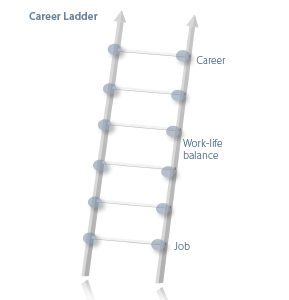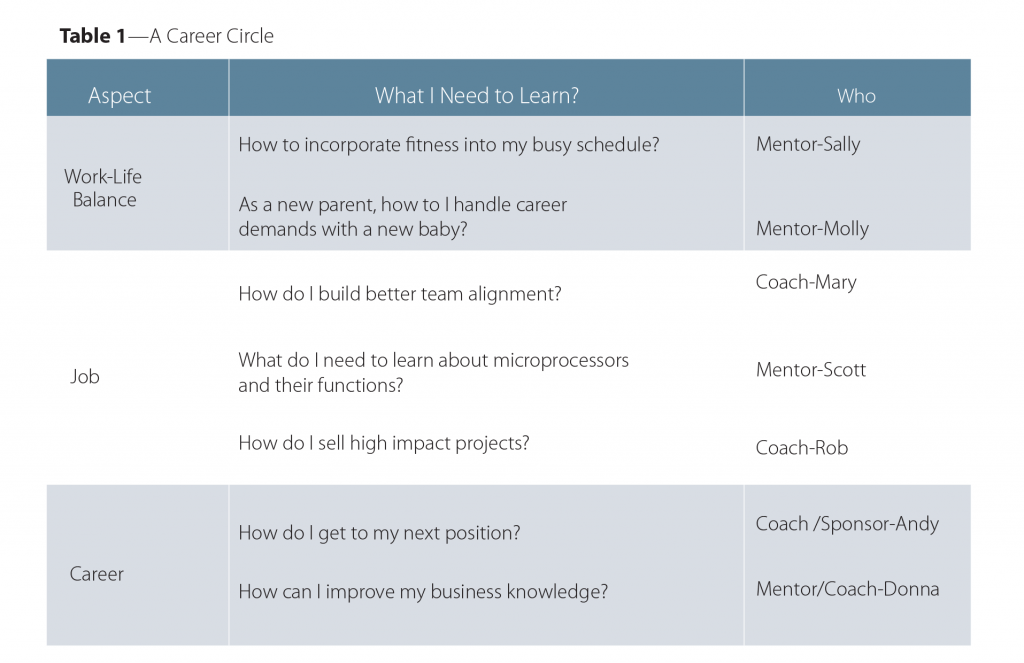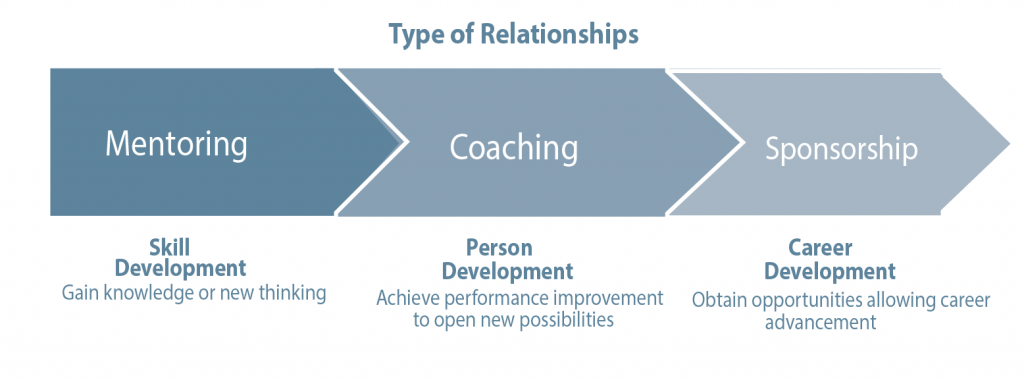 Sarah Kalicin is a senior statistician at Intel Corporation. For the last 15 years, she has led many career development efforts within various companies and created the workshop Developing Successful Career Relationships: Leveraging Mentoring, Coaching, and Sponsorship.
Sarah Kalicin is a senior statistician at Intel Corporation. For the last 15 years, she has led many career development efforts within various companies and created the workshop Developing Successful Career Relationships: Leveraging Mentoring, Coaching, and Sponsorship.
As we advance our careers and make bigger impacts on our organizations, we must gain new knowledge and perspectives, develop specific skills, and embrace beneficial experiences. We learn “what got you to your current position will not get you to your next one.” As with any new role, we all face different challenges, have barriers to overcome, and enter into unknown territory we must successfully maneuver.
When I started a previous position, this became abundantly clear. It was the first time I was not in a statistics group or reporting to another statistician. This created many situations I did not realize were a big deal and, at the time, was not equipped to handle. How do you convince an organization (or manager) that part of your role should be to lead the organization to improve decision-making, as opposed to the expectation of merely rubber-stamping the status quo? This was the first time I was responsible for defining my role and setting expectations for the use of statistical applications to benefit the organization. Anyone challenging an organization’s culture knows this is more an art than a science—one they do not teach in technical university; it is gained through experience.
A major lesson for me was that I had to gain new skills to be successful in my job. As time went on, I started to think about a new role and what new skills and experiences would make me successful. Moving up the career ladder is more about creating significant organizational impact than getting promotions. In fact, as our lives and careers evolve, we need to think about three aspects: our current job, our career direction, and our work-life balance.
The Career Ladder
A ladder is made up of three parts: the rungs, rails, and rung/rail connectors, which provide the structural integrity of the ladder. The career ladder is a metaphor for moving up the ranks, but the ladder components can also be a metaphor. Assume each rung of the ladder represents a job, the rails are the career, and the rung/rail connectors are work-life balance (See Figure 1). To move up a ladder, you need to ensure the rails are long enough to support more rungs. Likewise, to advance up a career ladder, you need to ensure you have the right knowledge, experience, and skills to transition to the next job (or rung). If you are successful in developing these skills, the rails should support you. If not, you could fall or be unsuccessful.
The ladder needs to have structural integrity for it to be functional, same with a career ladder. Spending too much time working, your personal life will suffer or burn out; being too focused on your personal life, your career will suffer. The connectors need to support the rungs and rails to allow the ladder to function. Work-life balance supports your job so you can have a career. As we go through our careers and our life, work and life demands will change. The manner in which we handle these demands will also need to change for us to be successful. The more effective we are at making these transitions, the more rewarding both our lives and careers will be.
Career Circles
Career circles represent the new skills, experiences, and knowledge you need to gain for that new position to have more impact or for you to move up rungs on your career ladder. They entail the ladder’s components to support your career growth. As shown in Figure 2, for each job or stage in your career, the circles will be different based on your development needs. They also will be different for everyone, since career paths are as unique as individuals are.
Here are career ladder component definitions and examples; together they make a career circle:
Current Job: Gain skills and behaviors that enable success in daily job duties. Examples include streamlining tasks to be more productive, building teams to gain more group efficiency, and learning information or methods allowing for success.
When I started in my previous position, many of my colleagues viewed me as an analyst, sending me data and expecting me to deliver the data conclusions. Many times, I had to respond detailing data-collection issues—basically, the results they were seeking were not achievable from their data design. I tried to explain that I could have helped them if they came to me before they collected data. After a while, people stopped asking for my support with their data needs and I realized I had to change my approach. Through training sessions, I was able to teach others how to benefit most from my services. I also started to showcase the accomplishments of others when I was engaged from the beginning of a project. Through these activities, I became more successful in my role, but I had to learn how to most effectively communicate with others, set expectations, and be my own PR agent.
Career: Identify opportunities and gain experiences to advance on the professional track. Examples include developing skills or experiences required for your next position, gaining knowledge or perspectives that allow you to lead teams or drive higher-impact projects, and building and executing meaningful organizational strategies.
One advantage of working for a large company is that they are frequently hiring for various positions. Using this to my advantage, I would scroll through the jobs online for positions that interested me. For any interesting opportunities (even if I was unqualified), I would schedule a half-hour meeting with the hiring manager to ask questions about their organization, the position, and which skills and experiences I would need to be successful in that role. Hiring managers were often open to meeting, providing many great suggestions, and considering what experience and skills I could learn within my current job or what other positions I could take to make the leap. It helped me identify the experience and skills I needed, and then seek out opportunities to develop in these areas.
Work-Life Balance: Gain awareness and skills to achieve greater work and life effectiveness. Examples include becoming a new or more engaged parent, maintaining a healthy lifestyle, and feeling successful equally at work and in life.
As a former triathlete, I found it difficult to get back into training when I had increased demands at work. After several attempts to get back into “training mode,” I struggled to maintain the consistency of training. I was disappointed because I lacked a fitness regimen and I thought I would not be able to balance work and fitness. It was a change in perspective that finally made me more at ease—doing something was better than nothing, even if that meant a 20-minute walk one day or swimming another day instead of an hour run every other day.
With these career circles, we should always be asking ourselves about what is holding us back from excelling in our position, getting to the next step in our career, or better balancing our responsibilities between work and life. Once I started to acknowledge what was holding me back, I was empowered to make the necessary changes.
Mentoring, Coaching, and Sponsorship
Through informational interviewing, I was able to identify people who already had the knowledge and experience I was looking for. Many people would suggest finding a mentor, and I think mentoring is one of the three relationships we need to incorporate into career development. Consider finding coaches and sponsors to augment career development opportunities.
Figure 3 defines the differences among mentoring, coaching, and sponsorship. Also consider the following analogy: Give a person a fish, she can eat for a day; teach a person to fish, she can eat for a lifetime.
- Mentoring is telling someone how to fish, what tools she might need and how it is done. To get a fish, go down to the edge of the water with a fishing pole with bait and wait for a bite. The mentor provides awareness about how to fish.
- Coaching is instructing the person, providing feedback and the opportunity to fish better. Use these lures, cast the lure out beyond the rocks, try snapping your wrist, tug on the line, etc. The coach allows for better fishing performance.
- Sponsorship is giving the person a boat, so she can fish in deeper water where there are more and bigger fish. Now the person is getting enough fish for herself to eat and she is able to sell the extra fish. She would not have been capable of obtaining the boat on her own, nor been given access to the bigger fish without the boat. The sponsor opened a door to make this opportunity possible.
As you think about your career circles and development needs, ask yourself what type of help you are seeking: mentoring, coaching, or sponsorship? Setting the right expectation for a successful development dialogue is important. Imagine the awkwardness if you need coaching, but the person provides mentoring. Your development needs might not be met. Make sure you identify the right type of relationship and people to guide you through the development you require. Use Table 1 as a template for creating your own career circles.
In Summary
As we move through our careers, we should think about development opportunities that allow us to feel successful and be who we want to be. Identifying where we want to go and what we need to learn are the first steps toward creating career circles—crucial steps for success. Leveraging other peoples’ experiences, skills, and knowledge helps expedite learning and propels us up the career ladder.
I hope this information empowers you to successfully own your career path and provides clarity for overcoming any barriers to achieving your aspirations. I know it has benefitted me.








Really good article!!!
Good description about mentoring/coaching and sponsoring.